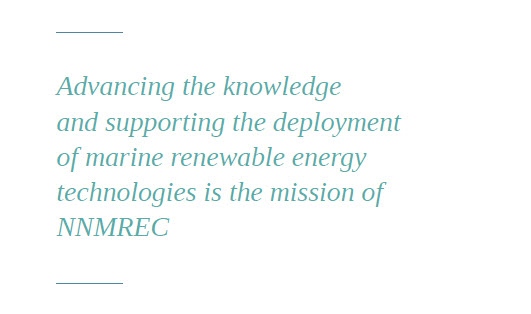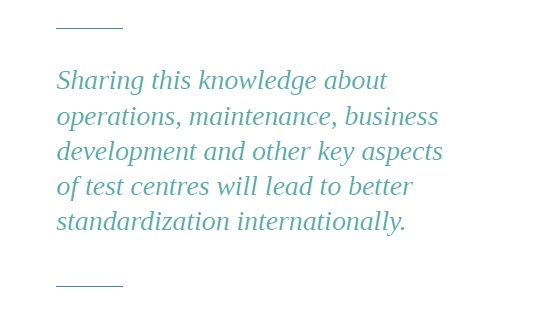Interview with NNMREC - USA
|
|
SAMANTHA QUINN
OPERATIONS MANAGERNNMREC |
 What was the motivation and the driving forces to build NNMREC and what milestones were set up for its development? To date, how much funding (public and private) has been granted for its creation and operation?
What was the motivation and the driving forces to build NNMREC and what milestones were set up for its development? To date, how much funding (public and private) has been granted for its creation and operation?
|
In 2008, the United States Department of Energy (DOE) invested $6.25 million to set up the Northwest National Marine Renewable Energy Center (NNMREC) with a variety of research and testing objectives, one of which directed the Center to develop integrated test facilities for marine energy. Advancing the knowledge and supporting the deployment of marine renewable energy technologies is the mission of NNMREC and its world class facilities that have been developed under the Pacific Marine Energy Center (PMEC) moniker. In 2012, DOE allocated an additional $4 million to begin developing PMEC – SETS (South Energy Test Site), planned as a deep-water test facility off the coast of Newport, Oregon. |
 |
Further funding was allocated again in 2015 and 2016 for just over $11M in funding from federal and non-federal sources towards the PMEC-SETS development. In 2016, NNMREC was awarded up to $40 million from the DOE to complete PMEC-SETS. The site will have 4 grid-connected berths, which can accommodate up to 20 WECs simultaneously, exporting up to 20MW of electricity to the grid. This pre-permitted site will allow for technology developers to focus on the challenges of operating in open ocean environments.
 It is recognised that test centres can be instrumental in proving the technology can work in challenging marine environments. What other benefits do you see for developers and also for local/regional communities?
It is recognised that test centres can be instrumental in proving the technology can work in challenging marine environments. What other benefits do you see for developers and also for local/regional communities?
NNMREC and PMEC provide an array of technical expertise and we have also worked conscientiously to build a strong relationship with the local and regional communities. PMEC sets is in an evolutionary state and we require this symbiotic relationship in order to gain the expertise of the community. The establishment of PMEC-SETS will provide further opportunities for developers to engage with the local community including engineering companies, vessel operators, port operators, divers, fishermen, who can all provide their expertise of the Oregon coast and ocean waters. This will also introduce more opportunities of involvement and potential jobs for the local and regional communities.
 For ocean energy in general, do you think test centres have a role to play on giving international visibility to the sector? Do you see improvement potential in this respect, and have suggestions?
For ocean energy in general, do you think test centres have a role to play on giving international visibility to the sector? Do you see improvement potential in this respect, and have suggestions?
Currently, there are only a few test centres in the world with open-ocean capabilities, and the other wave laboratories are fairly unknown to people outside of the local communities. By building more facilities, giving more opportunities for developers around the world to test in a variety of sea-states, the industry will see more improvement and the potential for a commercial industry sooner than projected.
Further, as NNMREC and PMEC is currently experiencing an influx of inquiries about the facility and about ocean energy in general, this highlights the idea that test centres do give a higher profile to the sector. The test facilities indicate that the sector is moving in a forward direction and that there is increasing confidence in the technologies.
 There are several test centres around the world, how do you see the possibility of knowledge sharing between these test centres? Apart from technology-specific details that are usually under non-disclosure, what information could be shared to support the sector?
There are several test centres around the world, how do you see the possibility of knowledge sharing between these test centres? Apart from technology-specific details that are usually under non-disclosure, what information could be shared to support the sector?
|
Knowledge sharing is definitely something that continues to be a delicate topic within marine energy research, especially with regard to technology. However, NNMREC, and PMEC, have partnered with EMEC in the development of the PMEC-SETS facility. This will help in the development of the PMEC-SETS site by gaining insight and an understanding of the lessons learned to insure that this new facility will meet the needs of the industry and provide the industry with new resources within facilities. Sharing this knowledge about operations, maintenance, business development and other key aspects of test centres will lead to better standardization internationally. Further, understanding the capabilities of other wave and tidal testing laboratories help to provide the industry on best guidance of where to test their technologies. |
 |
 Would you like to mention any key lessons from your experience over the operation of the test centre? Have expenses kept reasonably within foreseen limits, or were there any major unforeseen challenges?
Would you like to mention any key lessons from your experience over the operation of the test centre? Have expenses kept reasonably within foreseen limits, or were there any major unforeseen challenges?
In addition to the PMEC-SETS test facility, NNMREC also operates the PMEC- NETS (North Energy Test Site). This is non-grid connect site off the coast of Newport, Oregon where developers can either connect to NNMREC’s mobile ocean instrumentation test buoy or conduct self-contained tests. NNMREC has realised that having a test site without multiple berths is very expensive in terms of O&M costs and has not been utilised as much as originally anticipated.




